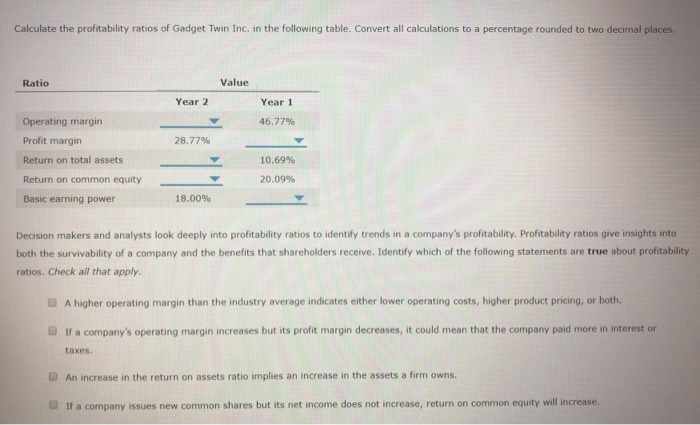5. Profitability ratios Profitability ratios help in the analysis of the combined impact of liquidity ratios, asset management ratios, and debt management ratios on the operating performance of a firm Your boss has asked you to calculate the profitability ratios of Gadget Twin Inc. and make comments on its second-year performance as compared to its first-year performance. The following shows Gadget Twin Inc.'s income statement for the last two years. The company had assets of $8,225 million in the first year and $13,157 million in the second year. Common equity was equal to $4,375 million in the first year, and the company distributed 100% of its earnings out as dividends during the first and the second years. In addition, the firm did not issue new stock during either year. Gadget Twin Inc. Income Statement For the Year Ending on December 31 (Millions of dollars) Year 2 Year 1 4,445 3,500 1.723 140 Net Sales Operating costs except depreciation and amortization Depreciation and amortization Total Operating costs Operating Income (or EBIT) Less: Interest Earnings before taxes (EBT) Less: Taxes (40%) Net Income 1,855 222 2,077 2,368 237 1,863 1,637 172 1,465 586 879 852 1,279 Calculate the profitability ratios of Gadget Twin Inc. in the following table. Convert all calculations to a percentage rounded to two decimal places Ratio Value Year 2 Year 1 46.77% Operating margin Profit margin 28.779 10.69% Return on total assets Return on common equity Basic earning power 20.09% 18.00% Decision makers and analysts look deeply into profitability ratios to identify trends in a company's profitability. Profitability ratios give insights into both the survivability of a company and the benefits that shareholders receive. Identify which of the following statements are true about profitability ratios. Check all that apply. A higher operating margin than the industry average indicates either lower operating costs, higher product pricing, or both. If a company's operating margin increases but its profit margin decreases, it could mean that the company paid more in interest or taxes. An increase in the return on assets ratio implies an increase in the assets a firm owns, If a company issues new common shares but its net income does not increase, return on common equity will increase








